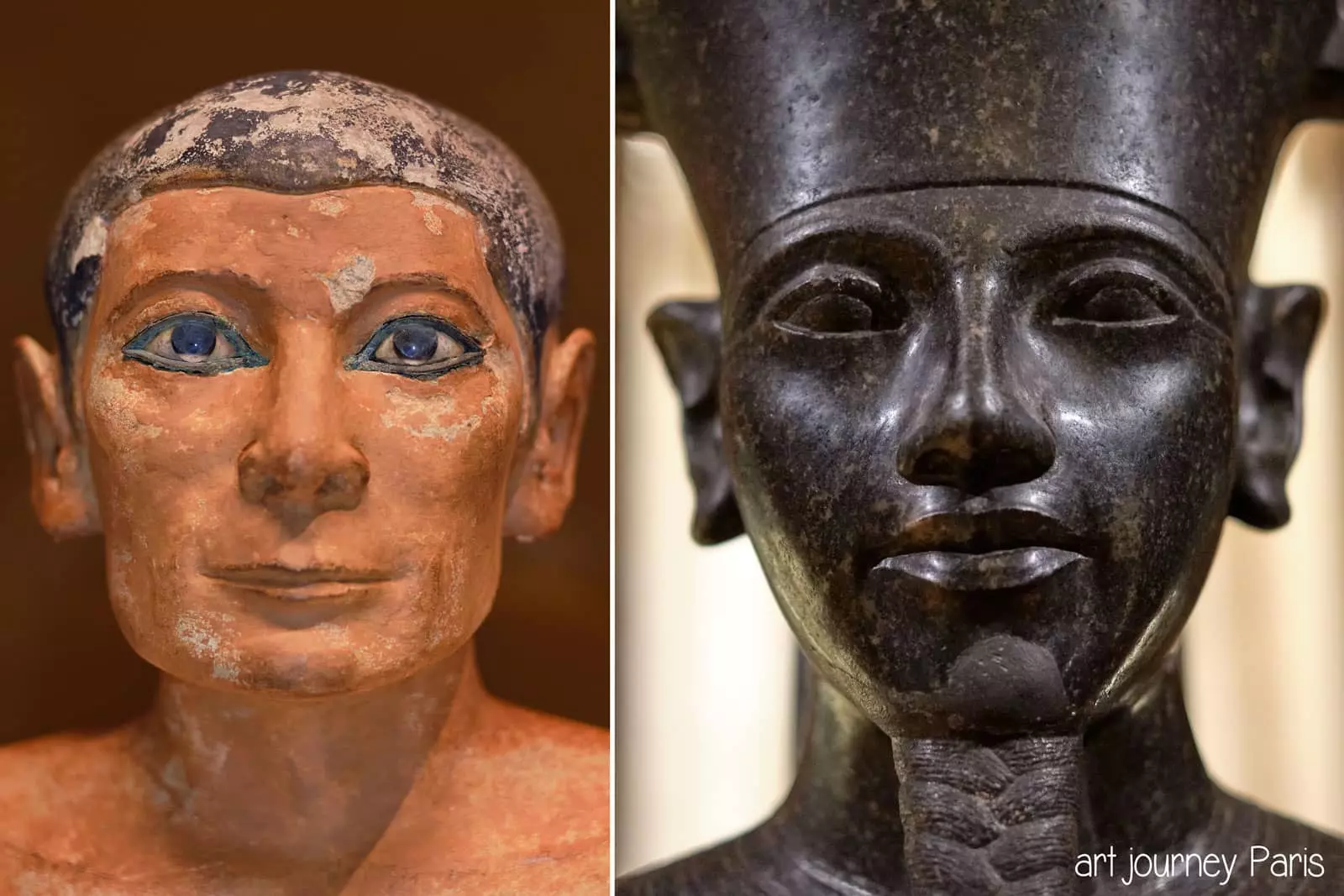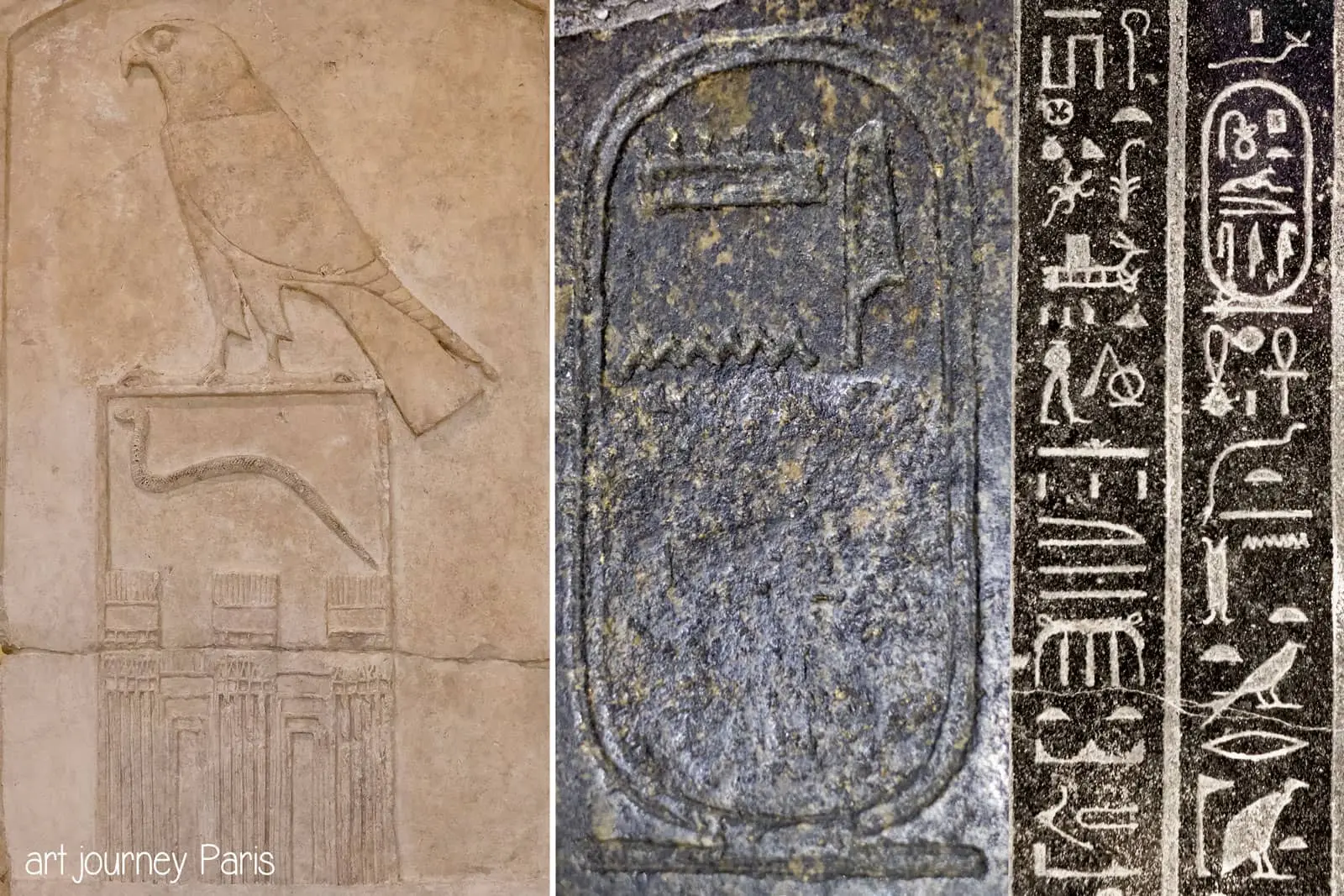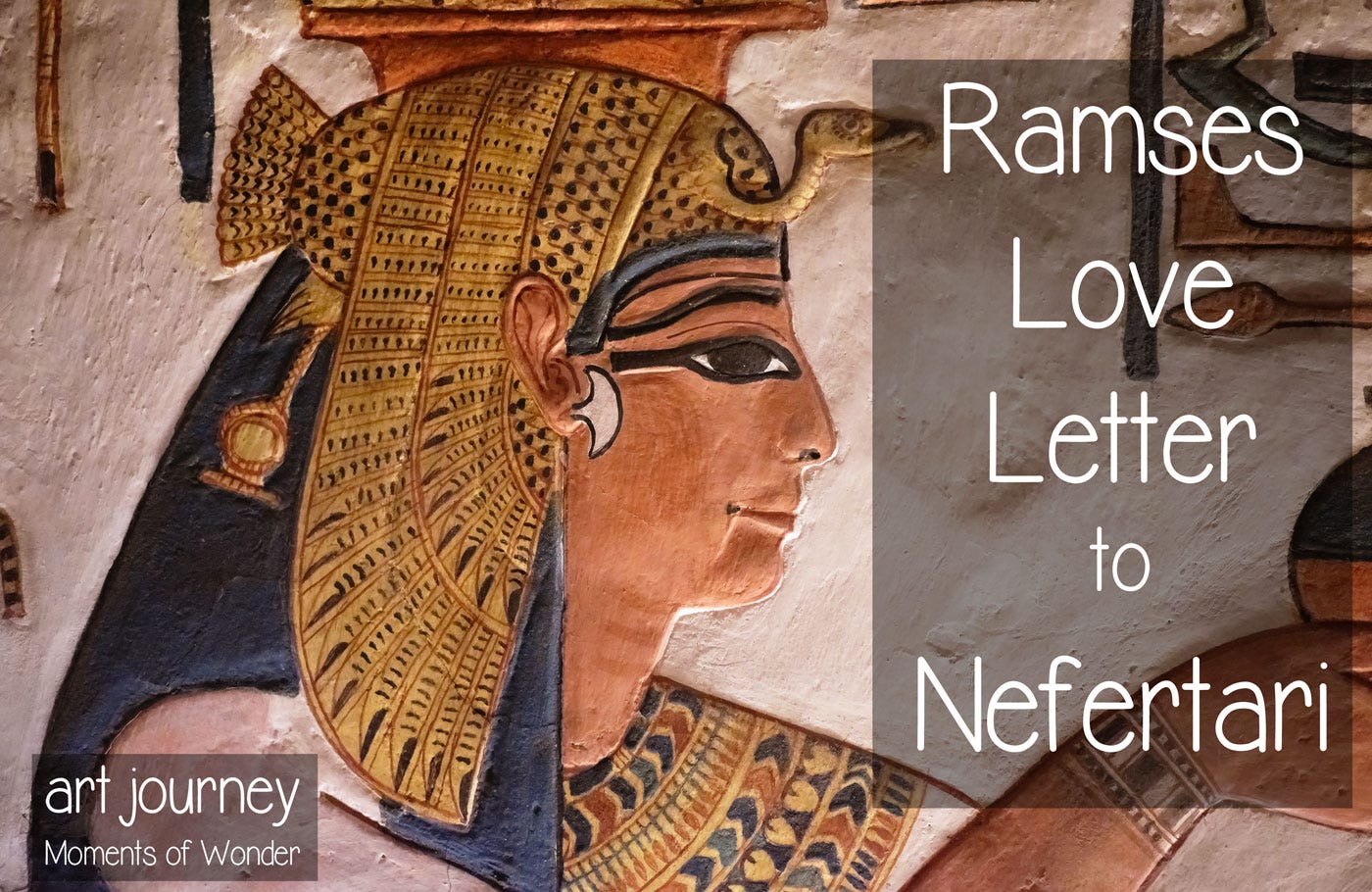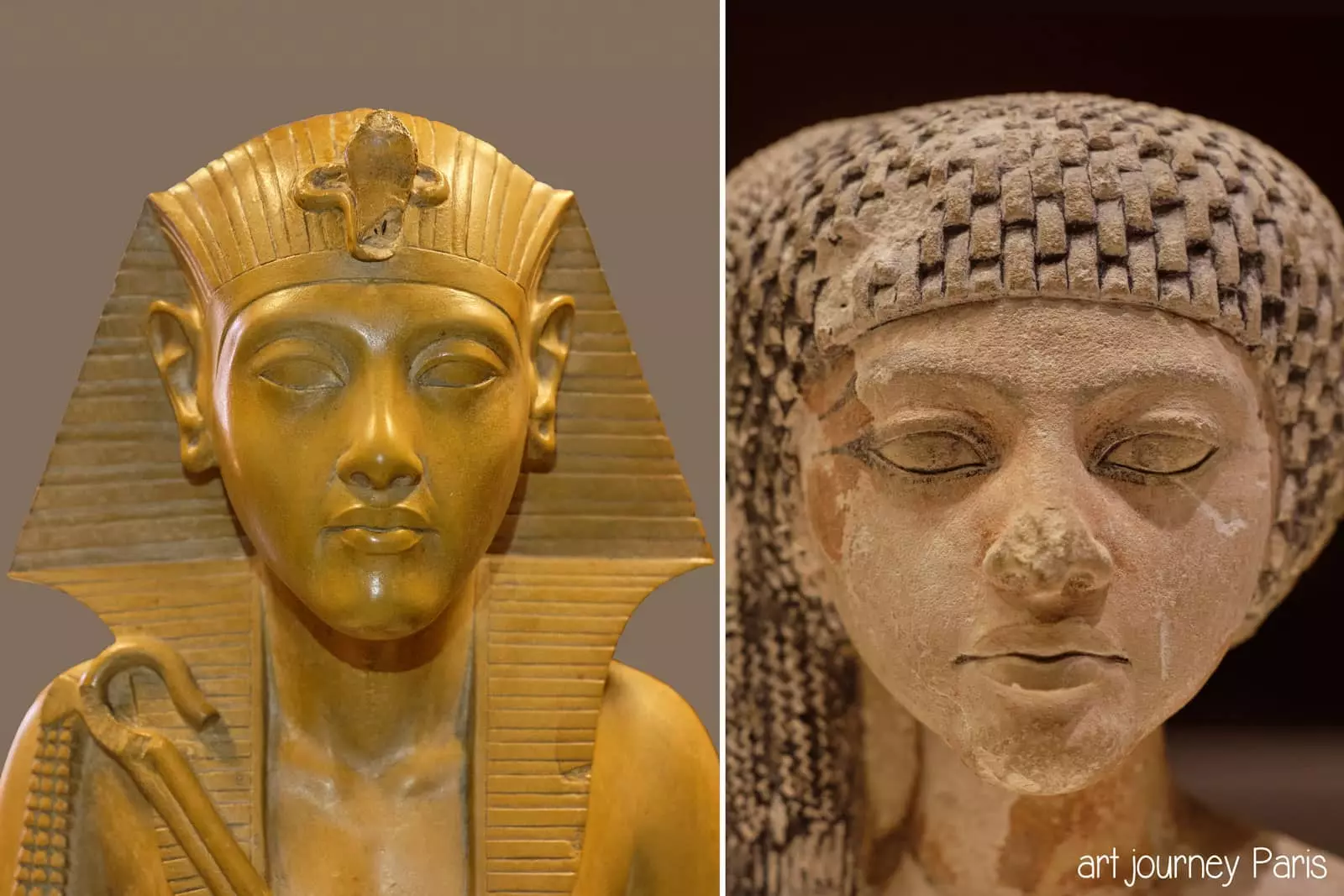
Masterpieces of the Louvre Department of Egyptian Antiquities private tour, with an initiation to hieroglyphs. The Seated Scribe, and Amun protecting Tutankhamun. Photo © Art Journey Paris.
Break the code like Champollion and understand hieroglyphs with a private tour of the Louvre Ancient Egyptian collection.
A Private Tour Of The Louvre Ancient Egyptian Department

Princess Nefertiabet, probably Pharaoh Cheops' daughter, and Pharaoh Sethi I, Ramses II's father, two of the Louvre Egyptian masterpieces. Photo © Art Journey Paris.
Champollion did not just translate hieroglyphs but also created the Louvre's Egyptian department. Today, it is one of the world's most important collections, displaying over 6,500 artworks from the first Pharaohs to Cleopatra.
Following in his footsteps we will discover the ancient Egyptian civilization. The strange signs carved in stone will start to make sense. Facing several mummies, we will realize that Egypt was not a gloomy civilization fascinated by death. An Art Journey private tour of the Louvre means understanding the ancient Egyptians' quest for eternal life.
𓏙𓋹 Understand Egyptian Hieroglyphic Writing

The Louvre exhibits three millennia of hieroglyphic writing, from one of the very first Kings of Egypt, Djet, to the erased cartouche of Tutankhamun and the Greek Pharaoh Ptolemy II. Photo © Art Journey Paris.
The key to revealing the ancient Egyptian civilization is starting to make sense of hieroglyphs. Before Champollion deciphered them, Egypt was a mysterious world. Mummies were eaten as a medicine, burnt as firewood, or unwrapped to spook people.
Art Journey offers the unique experience of a crash course in hieroglyphic writing and the Egyptian civilization in the Louvre museum. This is a kid-friendly visit, a fascinating adventure for children and adults.
So, if you are fascinated by tales about pyramids and the Rosetta Stone, you will be eager to discover there is a lot more to Egypt than death and mummies. Visitors of all ages will learn to identify a handful of hieroglyphs, starting with the sign for life. And quickly recognize that 'life' and 'eternal' are written about everywhere.
And gain the ability to read the names Tutankhamun, Ramses, and more in hieroglyphs! To top it up, you could walk to the nearby Place de la Concorde and understand the first visible line of text on Ramses II's obelisk.
Be On Familiar Terms With Ancient Egyptians
Once one relates with the ancient Egyptians' wish for eternal life and recognizes that their statues are crucial for their journey toward immortality, they become more than artworks. The wonder of our private tour of the Louvre is to connect with ancient Egyptians, as saying someone's name grants the person depicted eternal life.
As you will see Egypt isn't only about gods and Pharaohs, but also about the artisans who decorated the Valley of the Kings, architects and scribes. You will walk through the Louvre galleries and be on a first-name basis with husband-and-wife Sepa and Nesa, Nakhti, Karomama, having understood that saying the names of ancient Egyptians out loud grants them the eternal life they dearly hoped for.
A Genuine Private Tour Of The Louvre Egyptian Department

The impressive sphinx of Tanis, one of the largest sphinxes outside Egypt. It helps discuss the Great Sphinx of Giza. Photo © Art Journey Paris.
A private guided visit of the Egyptian Antiquities department of the Louvre lasting 4 hours, led by an officially licensed art historian guide.
1 to 2 people - 550 €
3 people - 675 €
4 people - 850 €
5 people - 975 €
Family (two adults, up to 3 children) - 550 €
The fee includes personalized Louvre entrance tickets with a time slot reservation guaranteeing access to the museum.
A Private Visit Of The Louvre Egyptian Collection
There are two different ways to experience ancient Egypt in the Louvre :
#1 - an introduction to ancient Egypt as part as a general discovery of the Louvre collection.
#2 - a private tour dedicated to ancient Egypt, for half a day. It is still possible to ask to see other rooms of the Louvre during the tour.
Visitors from all ages will be taught the basics of hieroglyphic writing, and become able to recognize a few important signs. They will be given printouts to keep and take home.
It is possible, on request, to also walk to the Place de la Concorde and discuss Ramses II's obelisk, a major ancient Egyptian masterpiece hiding in plain view. The special Egypt private tour is only available on weekends, Mondays, and Wednesdays. It is possible, not to say recommended, to take a coffee or tea break at one of the Louvre cafés during the visit.
Get a preview of a private tour reading and subscribing to Art Journey Moments of Wonder stories.

Ramses' love letter to Nefertari
When facts are more interesting than fiction.
Discover the true story of Ramses' love declaration to Nefertari.

When Ramses II became a living god
Ramses raising Nefertari toward the sun at Abu Simbel.
Discover how Ramses II became a living god.
Contact
To inquire about booking a private tour of the Louvre Egyptian Collection, please mention the date of the visit as well as the number of participants, using the form below, thank you.
Continue the discovery along the Nile with a Private tour of Egypt

The temples of Karnak and the Ramesseum without crowds. Discover ancient Egypt with a private tour from Cairo to Abu Simbel. Photo © Art Journey Egypt.
Have you long dreamed of seeing the pyramids and temples of ancient Egypt in real life? But hesitated, knowing that it would likely be a once-in-a-lifetime opportunity, and don't want to be just another tourist. Worry about missing important sites, being rushed, and failing to appreciate the meaning of the wonders in front of you?
Then, after having followed Champollion's footsteps inside the Louvre museum and admiring Ramses' obelisk a short walk away, the journey can continue along the Nile, from Cairo to Abu Simbel, with an expert-led private tour of Egypt's ancient monuments and civilization.
𓂀 𓂀
Discover the Louvre Ancient Egyptian department
How many ancient Egyptian artworks are on display in the Louvre?
Over 6,500 objects, including more than 1,600 statues and statuettes. Or if we dedicate one minute per object, for an entire day, seeing all the ancient Egyptian artifacts displayed in the Louvre would take two weeks...
Masterpieces of the Musée du Louvre Egyptian collection.
The impressive great Sphinx of Tanis isn't the only major wonder of the Louvre. A list of the greatest masterpieces of the Louvre would include :
- Tutankhamun. An important statue that was discovered before Howard Carter found the nearly intact tomb of the young Pharaoh.
- Nefertiti and Akhenaten. The era of Amenhotep IV - Akhenaten and his Queen, Nefertiti, is not just fascinating for its religious change, but also is one of the peaks of ancient Egyptian art, illustrated by the Amarna Princess.
- one of the very first Pharaohs of Egypt, Djet. His stela, found in the necropolis of the first Kings in Abydos, is 5,000 years old yet nearly intact.
- Queen Neferusobek, the first attested female Pharaoh of Egypt, not a 'King's Wife' or regent, but a female King. And the last native Pharaoh of Egypt, Cleopatra.
- the chapel of the mastaba of Akhethetep. Around 4,400 years old, an Ancient Kingdom wonder, the closest to actually being in Saqqara, entering the tomb of an official buried in close vicinity to Djoser's step pyramid, the first pyramid of Pharaonic Egypt.
- Ramses III sarcophagus. Ideal to discuss the length Pharaohs went to secure their eternal life.
- the seated scribe. No better way to feel that ancient Egyptian statues are 'alive' than to peer into the eyes of a 4,500 years old Egyptian. Sadly nameless, he was a man of high rank forever in the act of writing the 'words of the gods', hieroglyphs.
- gold and silver wonders. The fantastic treasures of the Pharaohs of Egypt are almost all lost to thieves, but the Louvre nevertheless houses small but impressive items, Osorkon's triad pendant, gold and silver cups given by Pharaoh Tuthmosis III to his general, rings belonging to Queen Nefertiti, Queen Ahhotep; Pharaoh Ahmose jewels, the Tod silver treasure, a pectoral with the name of Ramses II, and much more.
- another 'Rosetta Stone', a Greek era stela with Greek, demotic and hieroglyphic text, the decree of Canopus, found in 1801. For the 200th anniversary of the decipherment of hieroglyphs, such a rare artifact should help explain the difficulty of cracking the ancient Egyptian writing system.
- Karomama, the divine adoratrice of Amon. Is it the fact that bronze statuettes of this type are so rare? Or that Champollion called it "the most beautiful bronze ever discovered in Egypt"? Like the scribe, the only way to fully appreciate the wonders of ancient Egyptian art is to be face to face with Karomama, along with Nakhti, Nefertiabet, and more.
- Princess Nefertiabet, nearly intact while being 4,600 years old. A way to transport us to the great pyramids of Giza, as Nefertiabet was likely the daughter of one of the Pharaohs who built the pyramids of Giza, probably Khufu (Cheops).
The Louvre Egyptian collection is more than about Pharaohs and Gods
It is also about the craftsmen who built and decorated the tombs of the Pharaohs in the Valley of the Kings. We can come face to face with the artisans, with the architect of Hatshepsut's Deir el-Bahari million years temple, with Amenhotep III's sculptor. And read the proud boast of a craftsman who stated "I know the secret to hieroglyphs".
